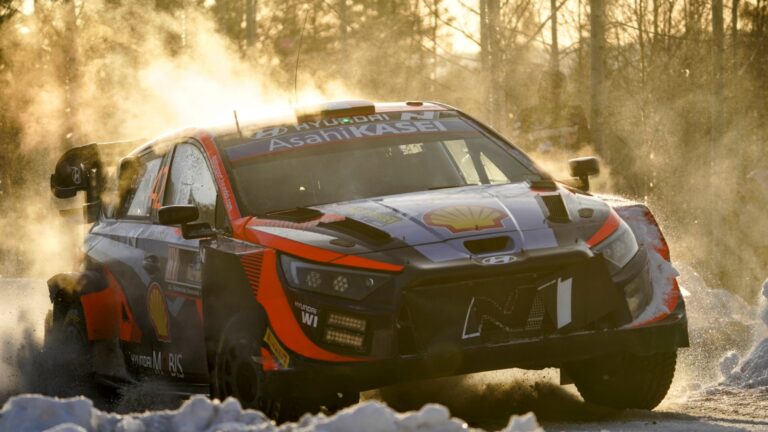Following the first meeting of the WMSC (World Motor Sport Council) in 2024, the FIA has released the first findings of its WRC working group. Established by FIA president Mohammed Ben Sulayem in 2023, the group was chaired by FIA deputy president for sport Robert Reid and WMSC member David Richards, with WMSC representatives Garry Connelly, Ronan Morgan and Andrew Mallalieu, and FIA executives Andrew Wheatley and Xavier Mestelan Pinon.
Its job was to try and plot a route for rallying, specifically the WRC, that would improve its reach while also defining a future direction for the sporting and technical regulations. The assembled expertise of the group members was augmented by data from the WRC fan engagement survey, completed in 2023.
The group’s suggestions certainly make for interesting, albeit slightly confusing, reading. The need to reduce costs for teams is clear, and suggestions such as the use of existing infrastructure for service parks (rather than teams taking their own units) and a cap on personnel make perfect sense. However, it is the technical regulations where the FIA’s intent is less clear.
The end of hybrid
The key takeaway is that the current Rally1 machines will stay, at least until 2026, but with the hybrids removed as of 2025. Yes, those are the same hybrids that just a few years ago were considered vital to manufacturer interest. Sadly, their introduction has been fraught and even three years in, the spec systems still prove troublesome, with teams frustrated that they can only develop workarounds for the issues rather than develop units that work. Not to mention the approximately €150,000 (US$162,500) they add to the cost of a Rally1 car, making customer sales challenging.
Slightly confusingly, the FIA states that performance will be compensated “by a reduction in overall weight, and a reduction in the air restrictor and aerodynamics”. Presumably this means that the weight will be dropped by removing the approximately 100kg hybrid, but the performance gain this would bring would then be pegged back by the engine and aero cuts.
These changes tie into what appears to be a Rally2+ class from 2025, with larger restrictors, the addition of paddleshift and a revised rear wing available to Rally2 cars running in WRC events, with the aim of “reducing the performance gap between Rally1 and Rally2 cars”. Whether this means Rally2 could compete for overall wins against Rally1 is not clarified.
From 2026, new Rally1 rules will come into play. The FIA states, “These regulations will run alongside the current Rally1 regulations for the 2026 season. These new rules will use a common safety cell to reduce costs and complexity and allow manufacturers and tuners to develop cars with their own bodywork based on production models including B-class, C-class, compact SUV or concept cars designed to tight technical criteria such as center of gravity and aerodynamics in order to equalize performance.
“The power output will be targeted at 330hp, with the engine performance controlled by a reference torque curve for all cars. Engine and transmission will be cost-capped and technology limited to Rally2 equivalence. Aerodynamic efficiency will be limited along with a top speed restriction to reduce development and cost. The cost per car will be capped at €400,000 and WRC manufacturers will be required to make their cars available for sale directly from the finish parc fermé of a WRC event.”
The FIA seems to be drawing on the WEC playbook of balance of performance while at the same time creating the conditions for Rally2 to move to a spaceframe chassis. This would be considered desirable thanks to the safety features of the Rally1 chassis compared with production-based machines. Such a move could also help long term as the supply of small, ICE-only hatchback cars starts to dry up.
The wish for an all-electric class, with performance parity with Rally1 running on “sustainable fuel” is also floated, though no idea of timescale is given. There is no mention of H2 for rally (though technically it is a sustainable fuel) but at the same WMSC meeting the decision was taken to pursue liquid H2 as a solution for motorsport more generally. Could an H2 ICE solution fit into the cost constraints of the new rules? One would think it unlikely at the moment.
Frustratingly, the FIA is light on detail regarding the reasons behind these changes. What were the motivating factors? Initial feedback from PMW’s sources suggests that not all manufacturers are on board with the proposals. Although it is clear that the Rally1 regulations haven’t had the desired effect of bringing more entrants to the class, there is little to suggest that the new proposals will change the status quo. With final technical regulations due in June, it will be interesting to see how much horse trading takes place in the interim. The foundations of a more cost-effective top class, while not diluting the spectacle, appear to be there but as ever, the devil will be in the detail.



